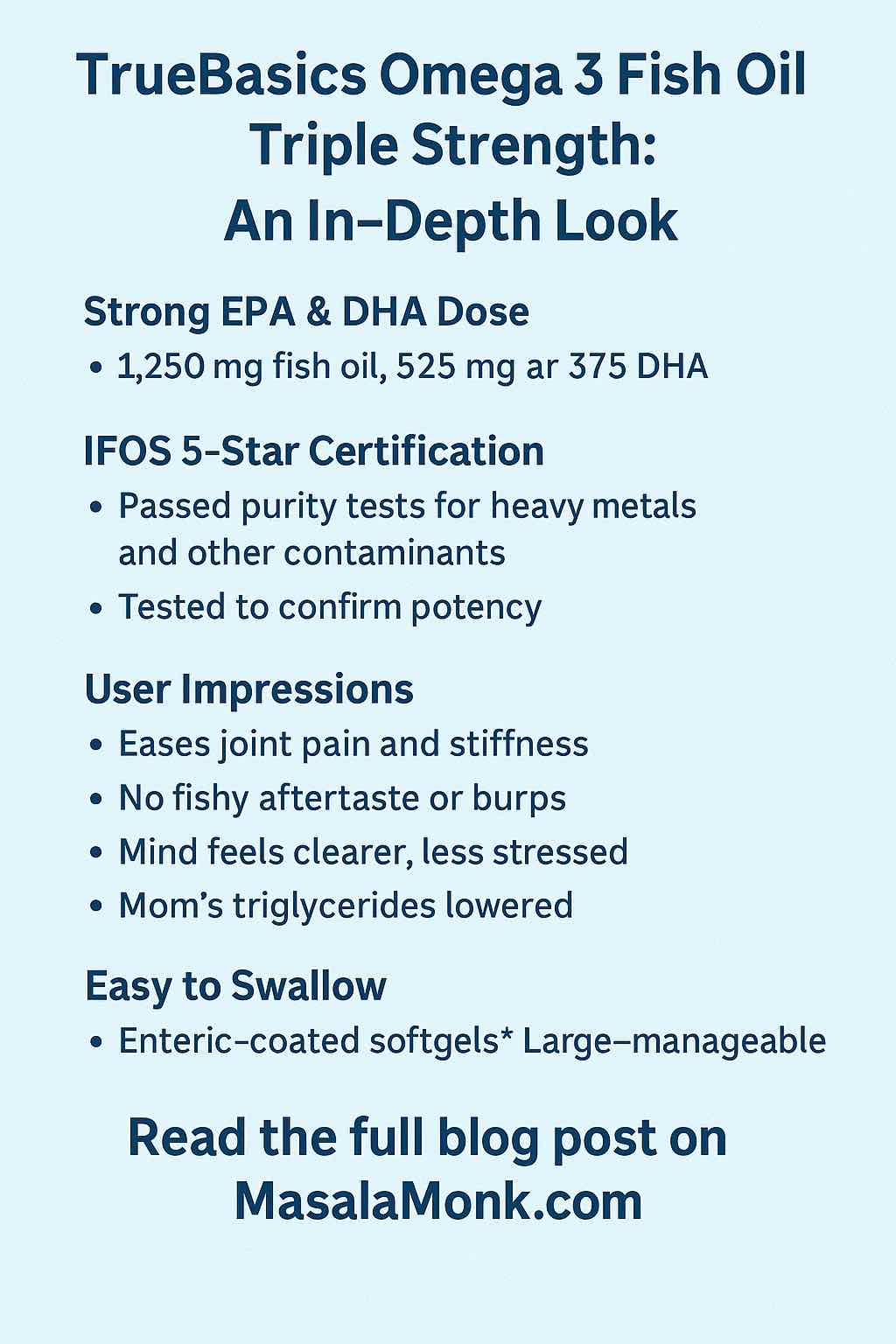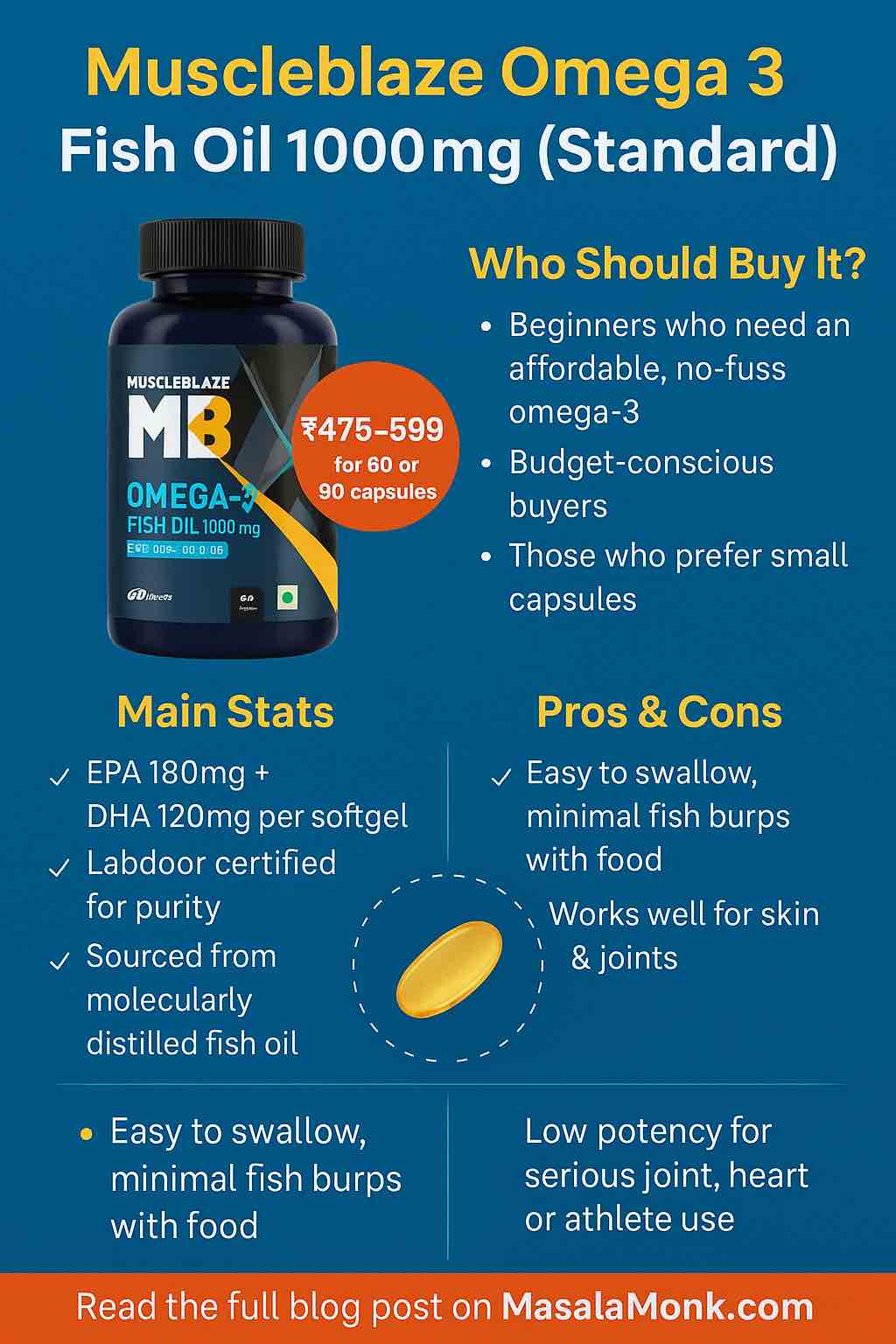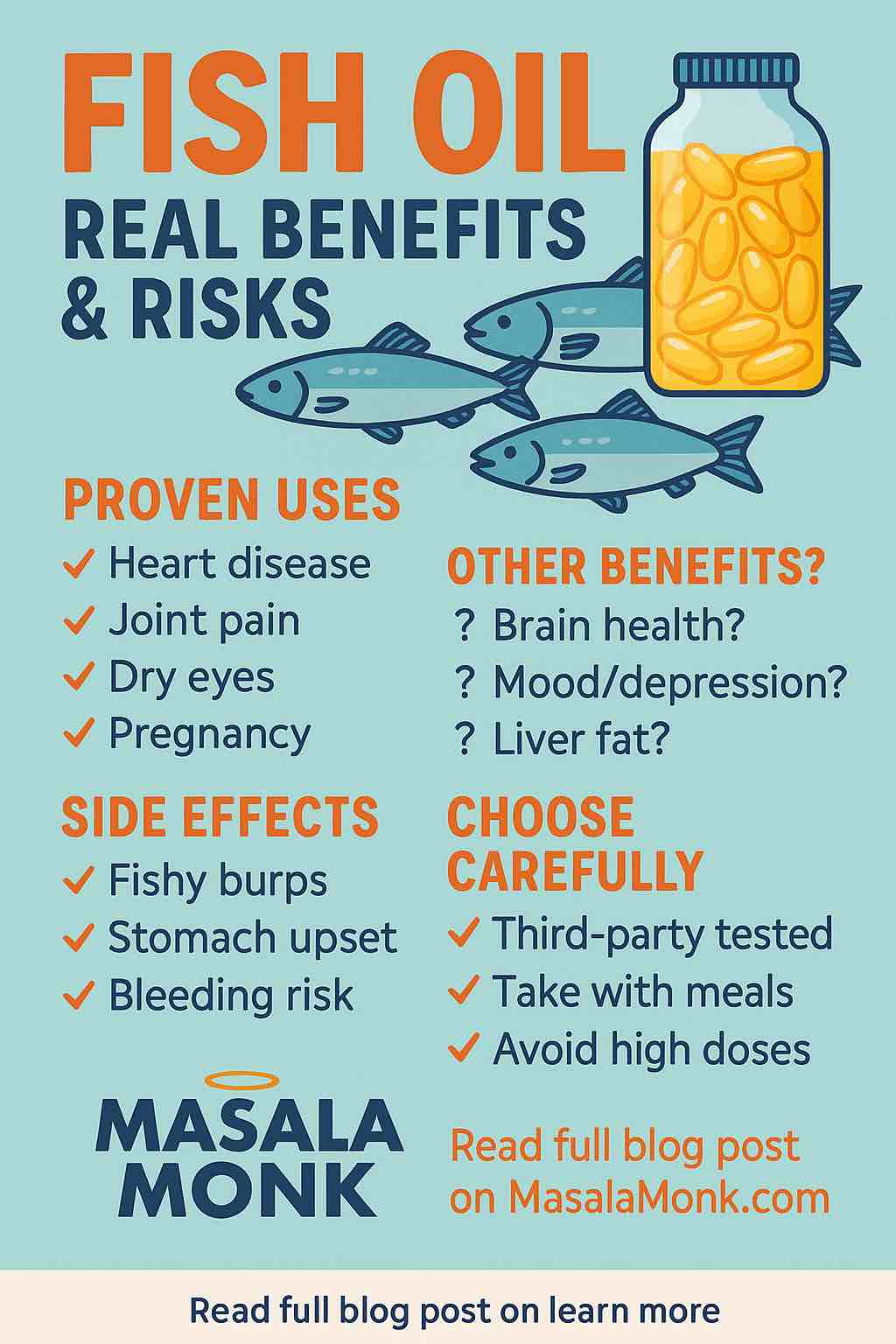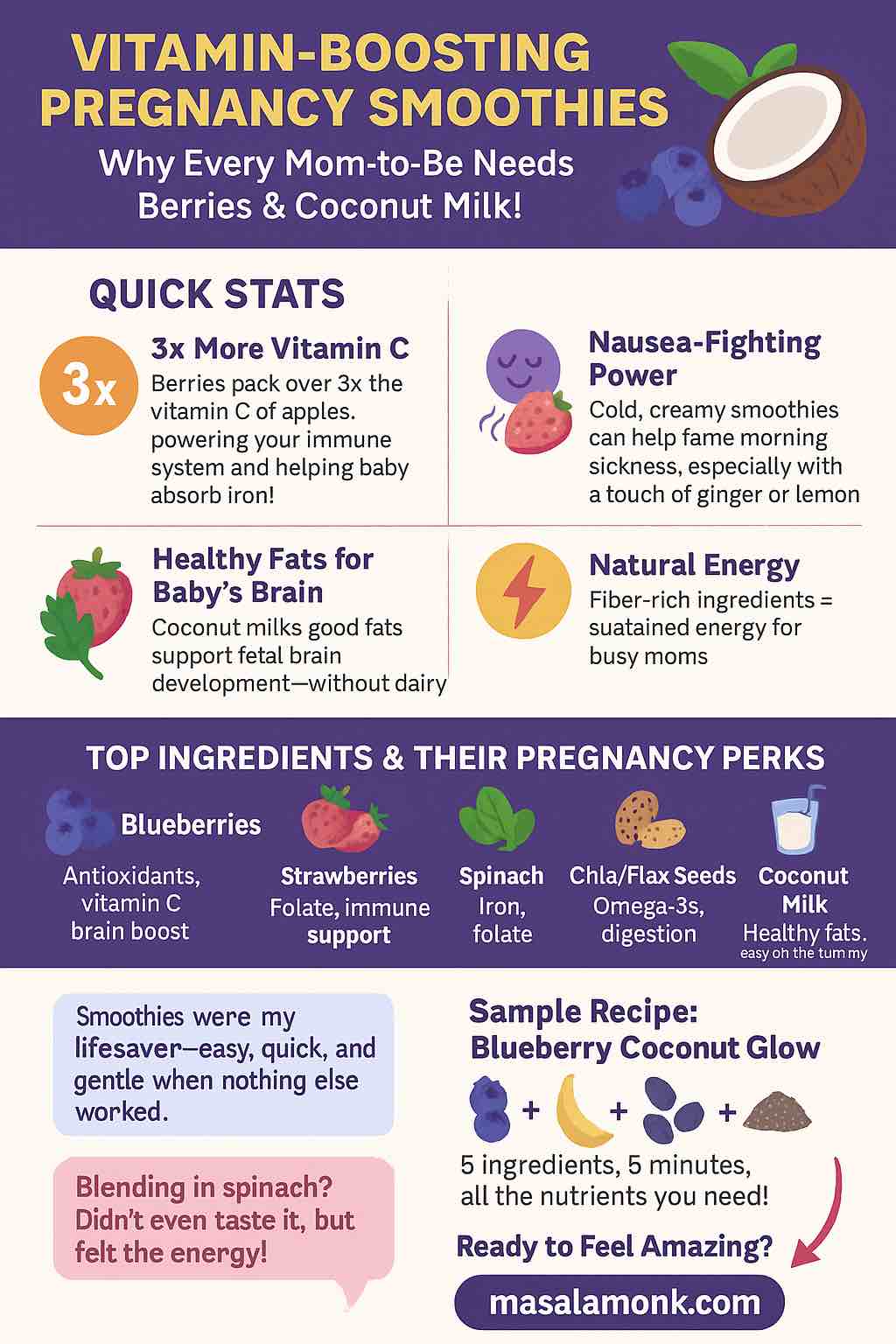
India’s modern lifestyle, growing fitness culture, and dietary gaps have put omega-3 supplementation front and center for everyone—from athletes and bodybuilders to busy professionals, seniors, and people with chronic inflammation or lifestyle diseases.
But not all omega-3s are equal.
Many “fish oil” brands underdose, hide their sourcing, or cut corners on purity. Only a handful truly offer “clinical strength” and third-party certification.
TrueBasics Omega 3 Fish Oil (Triple Strength) is now a top pick for health-conscious Indians—offering IFOS 5-star certified purity, real triple-strength dosing, and a clean, well-absorbed formula. But is it really better, and does it justify the price tag?
Let’s break it all down—ingredients, certifications, absorption, real Indian user reviews, science, practical tips, and honest comparisons.
Also Read: What Is Fish Oil Good For? Benefits, Side Effects, and More
Product Deep-Dive: TrueBasics Omega 3 Triple Strength
Quick Facts
- Strength per Capsule:
- 1,250 mg fish oil (525 mg EPA, 375 mg DHA, 100 mg “other” omega-3s)
- International Certifications:
- IFOS 5-Star Certified (gold standard for purity and potency, Canada lab)
- Clean Label, GMP, ISO, HACCP—tested for heavy metals, mercury, PCBs, and dioxins
- Purification Process:
- Molecular distillation—removes toxins, pollutants, and “fishy” compounds
- Absorption:
- Triglyceride (TG) form (closer to what’s found in fish)—NOT cheap ethyl ester (EE), so your body absorbs more with every dose
- Capsule:
- Enteric-coated softgel—delivers to the intestine for best absorption and less aftertaste
- Non-vegetarian (fish oil + gelatin capsule)
- Additives:
- Minimal—only natural vitamin E (tocopherol) to protect freshness, NO artificial colors/flavors
- Price Range:
- ₹649–₹899 for 60 softgels (Amazon Link)
Science-Backed Benefits: What to Expect (When Used Consistently)
EPA and DHA (the active omega-3s in fish oil) are essential for:
- Heart health: Reduces triglycerides, supports cholesterol, and lowers cardiovascular risk
- Brain and cognitive health: May improve mood, memory, and long-term brain aging
- Joint comfort: Clinical studies show reduced joint pain and morning stiffness in people with arthritis or active lifestyles
- Muscle recovery: Accelerates post-workout repair, reduces inflammation
- Skin and hair: Supports a radiant glow, helps with dryness and flakiness
- Eye health: DHA is a structural component of the retina—may protect long-term vision
BUT: All these benefits require a true clinical dose (ideally 1,000 mg/day or more of EPA+DHA), consistent use, and reliable purity (no heavy metals, oxidation, or fillers).
Also Consider: Tata 1mg Triple Strength Omega 3 Fish Oil Review (560 mg EPA + 400 mg DHA)
TrueBasics: What Sets It Apart in the Crowded Indian Market?
1. Real Triple Strength in 1 Capsule
- Many Indian fish oils offer only 180 mg EPA + 120 mg DHA (you’d need 4–5 pills daily for clinical effect!)
- TrueBasics delivers 525 mg EPA + 375 mg DHA in one softgel
- 1–2 pills daily covers most research-backed doses for heart, joint, and brain benefits
2. IFOS 5-Star Certification—A Rare Global Standard
- Most Indian brands skip global testing; TrueBasics batches are certified by the International Fish Oil Standards (IFOS), confirming purity, potency, and oxidation levels
- Each batch’s results are available for transparency—major plus for serious users
3. Superior Absorption & “Burpless” Formula
- Triglyceride (TG) form—absorbed up to 50% better than the EE (ethyl ester) forms used by many budget brands
- Enteric coating means less aftertaste, reduced fishy burps, and improved GI tolerance—even for sensitive stomachs
- Most users confirm: “No burps, no reflux, easy to digest” in verified reviews
4. Minimal, Clean Formula
- No artificial flavors (unlike Neuherbs lemon or MB Gold vanilla)
- No hidden sugar, sweeteners, or cheap fillers
- Only natural vitamin E for shelf stability
5. Widely Trusted Among Indian Doctors and Nutritionists
- Many Indian users switch to TrueBasics after their doctor/nutritionist recommends a “clinical strength” IFOS-tested product
- Repeat buyers often mention using it for over a year with no issues
What Real Users Are Saying (Amazon, Nykaa, Reddit, Healthkart)
⭐ Real-World Results
- Joints and arthritis:
“My mother’s knee pain has reduced, and my post-exercise soreness is much less after 3 weeks.” - No aftertaste or GI upset:
“I can take it even without breakfast and never get burps—so much better than my last brand.” - Skin and hair:
“Skin is less dry, and my hair looks shinier since I started taking TrueBasics.” - Cognitive and mood boost:
“Sharper focus, feel less stressed, and even sleep seems better.” - Doctor approved:
“My cardiologist prefers IFOS or Labdoor tested fish oil, so I stick to this.”
❗ Common Critiques
- Capsule size:
“A bit large—easier than some, but not for people who hate big softgels.” - Price:
“It’s pricier than others, but you’re getting a clinical dose and real purity.” - Occasional odor on opening:
“One pack smelled a bit fishy, but it was within expiry and the pills worked fine.” - No dramatic miracle:
“Helps over time, not a quick-fix—need to use daily for best results.”
⭐ User Trends
- Many switch from lower-dose or non-certified fish oils and report “feeling a real difference.”
- Repeat buyers are common—some for 12+ months without breaks.
- No reports of heavy metals or rancidity issues.
How To Use TrueBasics Omega 3 for Best Results
- Dosage: 1 softgel daily for prevention/wellness, 2 daily for clinical needs (consult your doctor if you want to go higher)
- Timing: With breakfast or lunch (must be a meal containing some fat—milk, paneer, eggs, avocado, or ghee/oil)
- Storage: Cool, dry place; refrigerate if you live in a very hot climate or store for long periods
- Check the batch: Avoid capsules with strong fishy odor or cloudy oil—request replacement if needed
- How long for results? Most see changes in joint, skin, or energy within 3–6 weeks; long-term heart/brain effects build over months
Comparison Table: TrueBasics vs All Top Omega-3 Brands in India
| Product & Review Link | EPA/DHA per Cap | Price (60 caps) | Certifications/Features | Buy Link |
|---|---|---|---|---|
| TrueBasics Omega 3 | 525/375 mg | ₹649–₹899 | IFOS 5-star, TG, enteric, clean | Amazon |
| Tata 1mg Triple Strength | 560/400 mg | ~₹715 | TG, enteric, pharmacy trust | Amazon |
| MuscleBlaze Gold Triple Strength | 500/400 mg | ~₹875 | Max EPA, vanilla, TG | Amazon |
| Neuherbs Deep Sea Omega 3 | 446/297 mg | ~₹699 | Lemon, D3/E, EE form | Amazon |
| Carbamide Forte Triple Strength | ~495/330 mg | ~₹699 | Bestseller, good value, EE | Amazon |
| Wellbeing Nutrition Omega 3 | 612/408 mg | ~₹948 | Curcumin, slow release | Amazon |
| MuscleBlaze Standard | 180/120 mg | ~₹475 | Starter, small capsule | Amazon |
See all reviews and comparisons in the Best Fish Oil Supplements on Amazon India guide.
Pros, Cons & Value Assessment
✔️ Pros
- High EPA/DHA per capsule—fewest pills for clinical dose
- IFOS 5-star = real purity and potency, global trust
- TG-form + enteric coating = max absorption, less reflux
- Minimalist, clean formula—no fake flavors or sweeteners
- Strong user loyalty—many repeat buyers, high average rating
- Consistent performance for joints, skin, heart, and recovery
❌ Cons
- Large softgel: Not for those who hate big pills
- Higher price: Cost per capsule is premium, but per mg of EPA/DHA is actually competitive
- Rare odor complaints: May be storage-related, not a product flaw
- Not flavored: Not lemon/vanilla like Neuherbs or MuscleBlaze Gold
- Not vegetarian/vegan
Who Should Buy TrueBasics Omega 3?
- Anyone wanting true clinical-dose omega-3 for joint, brain, heart, or muscle health
- Users who prioritize global certification (IFOS 5-star)
- People switching from underdosed or cheap fish oils and not seeing results
- Long-term users—those serious about cumulative wellness benefits
When to Consider Alternatives
- If you want a lemon/vanilla flavored pill for taste—try Neuherbs or MuscleBlaze Gold
- If you struggle with big capsules (see MuscleBlaze Standard)
- If you’re vegan/vegetarian (choose algae-based omega-3)
- If you only want the cheapest option per bottle (Carbamide Forte is a low-cost alternative, but with lower EPA/DHA per capsule)
Final Verdict: Is TrueBasics Omega 3 Worth It for Indian Users?
For Indian adults wanting genuine, clinical-strength, clean, and globally-certified omega-3—TrueBasics is among the best money can buy.
- Transparent labeling and 5-star IFOS purity means you know exactly what’s in your supplement—no hidden surprises.
- Real clinical dose in just 1–2 pills means less hassle, better compliance, and true results (backed by real users).
- Minimalist formula, maximum absorption, and no burps for most users.
Yes, it costs more than generic fish oil—but if you want quality, safety, and true benefit, it’s an investment worth making.
Ready to try TrueBasics?
👉 Order on Amazon (official listing)
Don’t Miss These Essential Resources:
- Best Fish Oil Supplements on Amazon India – 7 Compared
- What is Fish Oil Good For? (Benefits, Side Effects & More)
- Tata 1mg Triple Strength Omega 3 Review
- MuscleBlaze Gold Triple Strength Review
- Neuherbs Deep Sea Omega 3 Review
- MuscleBlaze Standard Omega 3 Review
Disclosure: Affiliate links may earn us a commission, helping support independent research at no extra cost to you.
10 FAQs for TrueBasics Omega 3 Fish Oil (Triple Strength)
1. What is the EPA and DHA content per capsule in TrueBasics Omega 3 Triple Strength?
Each softgel contains 525 mg EPA and 375 mg DHA—much higher than standard Indian fish oil capsules.
2. Is TrueBasics Omega 3 IFOS 5-star certified, and why does it matter?
Yes, every batch is IFOS 5-star certified—the highest global standard for fish oil purity, potency, and freshness. This means every bottle is independently tested for heavy metals, toxins, and oxidation.
3. What form of omega-3 is used—triglyceride (TG) or ethyl ester (EE)?
TrueBasics uses the triglyceride (TG) form, which is much better absorbed by the body compared to the ethyl ester form in cheaper brands.
4. How many capsules should I take daily?
1 capsule daily is sufficient for general health; 2 capsules daily may be used for specific therapeutic needs (consult your doctor).
5. Will I get fishy burps or aftertaste?
Rarely. The enteric-coated softgel ensures most users experience no fishy burps or aftertaste, even if taken without food.
6. Is this product vegetarian or vegan?
No, it contains fish oil and a gelatin capsule. Vegetarian/vegan users should consider algae-based omega-3 supplements.
7. Are there any artificial colors, flavors, or preservatives?
No, TrueBasics uses a minimalist formula—no artificial colors, flavors, sweeteners, or unnecessary additives.
8. How should I store the capsules for maximum freshness?
Store in a cool, dry place, away from direct sunlight. In hot climates, refrigeration is recommended to maintain potency and prevent capsule softening.
9. How long until I notice benefits?
Most users report improvements in joint comfort, skin, energy, or recovery within 3–6 weeks of daily use. Heart and brain benefits build with long-term consistency.
10. How does TrueBasics compare to other top Indian omega-3 brands?
It offers clinical strength, TG-form, and IFOS 5-star certification in one of the most potent and globally trusted formulas—beating most local brands on purity, dose, and transparency.













